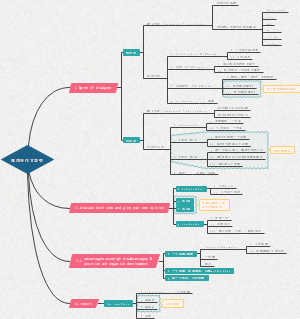导图社区 Invitations to Linguistics语言学
- 19
- 0
- 0
- 举报
Invitations to Linguistics语言学
这是一篇关于Invitations to Linguistics的思维导图, 语言是用于人类交流的任意语音符号系统。
编辑于2024-04-12 21:23:22- 语言学
- 相似推荐
- 大纲
Invitations to Linguistics
What is language?
Language is a system of arbitrary vocal symbols used for human communication.
Design Features of Language
Arbitrariness
Arbitrary relationship between the sound of a moroheme and its meaning.
Arbitrariness at the syntactic level.
Arbitrariness and covention
Duality
having two levels of structures, such that units of the primary level are composed of elements of the seconfary level and each of the two levels has its own principles of organization.
language is hierarchical
Creativity
language is resourceful because of ite duality and its recursiveness.
Displacement
human languages enable their users to sumbolize objects, events and concepts which are not present (in time and space) at the moment of communication.
benefits huamn beings by giving them the power to handle generalizations and adstractions
Once we can talk about physically distant thig, we acquire the ability to understand concepts which denote "non-things," such as truth and beauty.
Reflexivity
The ability to use language to talk about lanuage
Human language can be used to talk about itself
Origin of Language
"in the beginning was the Word, and the Word was with God, and the Word was God.'
The "bow-wow" theory
In primitive times people imitated the sounds of the animal calls in the wild envoronment they lived and speech developed from that.
The "pooh-pooh"theory
In the life of our primitive ancestors, they utter instinctive sounds pain,anger and joy.
The "yo-he-ho" theory
As primitive people worked together, they produced some rhythmic grunts which gradually developed into chants and then into language.
Functions of Language
addresser
Emotive
context
Referential
message
Poetic
contact
Phatic
code
Metalingual
adressee
Conative
Informative Function
Language is the instrument of thought and people often feel they need to speak their thoughts aloud, for instance, when they are working on math problem. The use of language to record the facts is a prerequisite of social development. This is indeed a crucial function of language.
Interpersonal Function
refers to function enacts social relationships
language has the function of reflecting relationships between people.
to build and maintain relationship of all kinds
reflects our social idential and status
to judge and evaluate things
Performative Function
is primarily to change the social status of [peoples, as in marriage ceremonies, the sentencing of criminals, the blessing of children, the naming of a ship at a launching ceremony, and the cursing of enemied. The kind of language employed in perdormative verbal acts is usually quite formal and even ritualized.
Emotive Function
is one of the most powerful uses of language because it is crucial in changing the emotional status of an audience for or against someone or something.
Phatic Communion
small, seemingly meaningless expressions to maintain a comfortable relationship between people without involving any factual content.
Recreational Function
often overlooked
no one will deny the use of language for the hearty joy of using
Metalingual Function
be used to talk about itself
This makes the language infinitely self-reflexive: We human beings can talk about talk and think about thinking, and thus only humans can ask what it means to communicate, to think, to be human.
What is Linguaistics?
It is based on the systematic investingation of linguistic data coducted with reference to some general theory of language structure.
Linguistics is usually defined as the science of language or, alternatively, as the scientific study of language.
is not just one language of any one community but the language of all human beings.
Main Branches of Linguistics
Phonetics
Phonology
Morphology
Syntax
Semantics
Pragmatics
Macrolinguistics
Psycholinguistics
ociolinguistics
Anthropological Linguistis
Computational Linguistis
Important Distinctions in Linguistics
Descriptive vs. Prescriptive
The distinction lies in prescribing how things ought to be and describing how things are.
the linguistic tried to discover and record the rules to which the members of a language community actually conform and does not seek to impose upon them other reles, or norms , of correctness.
In the 18th century, all the main European languages were studied prescriptively.
Synchronic vs. Diachronic
A Synchronic description takes a fixed instant (usually, but not necessarily, the present) as its point of observation.
Saussure's diachronic linguistic is the study of a language through the course of its history.
Langue vs. Parole
Saussure distinguished the linguistic competene of the speakers and the actual phenomena or data of linguistics as ;langue and parole.
Competence & Performance
A language user's underlying knowledge about the system of rules is called his linguistic competence.
performance refers to the actual use of language in concrete situations.
A speaker's competence is stable while his performance is often influenced by psychological and social factors. So as speaker's performance does not always match his supposed competence.
Chomsky believes that linguists ought to study competence, rather than performance.
Ethnic background
socioeconomic status
region of the country
physical state (intoxication、fatigue、distracion、illness)vary fron individual to individual)









